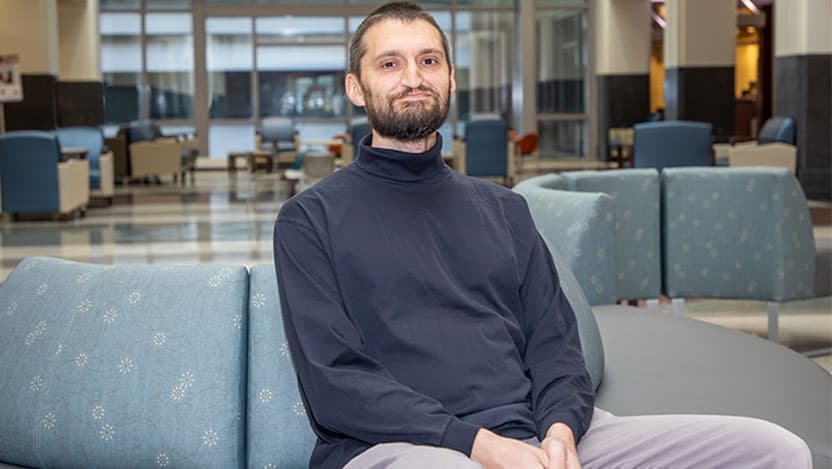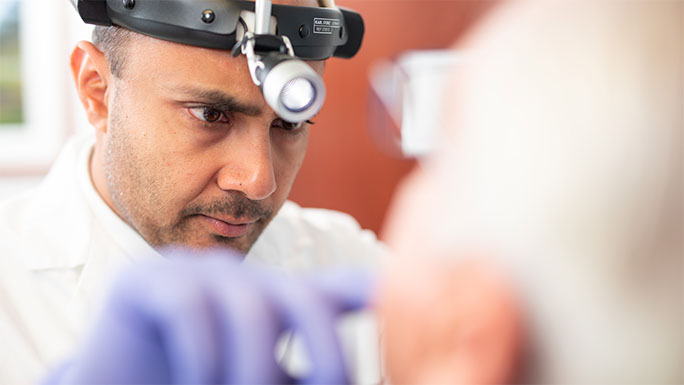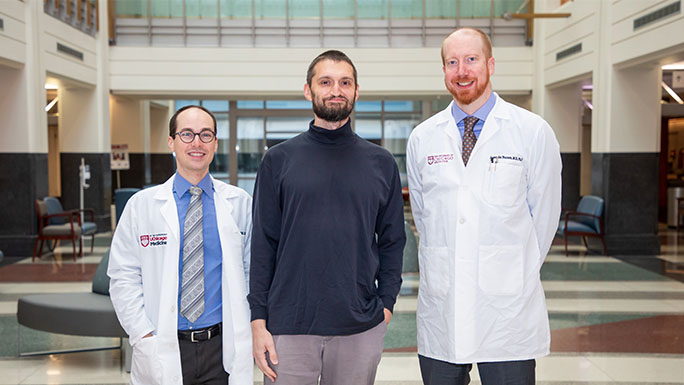Sobrevivió al cáncer, ahora lo estudia

Dmitry Karpeyev, PhD, se dio cuenta por primera vez de que algo estaba mal cuando desarrolló una congestión nasal crónica. Cuando finalmente vio a su médico, recibió noticias devastadoras. Su congestión era causada por un gran tumor en la base de su cráneo.
Se necesitaría un equipo de siete médicos para extirpar el tumor, tratar su cáncer y en última instancia, salvar la vida del científico en computadores. Desde entonces, Karpeyev ha mostrado su gratitud ofreciendo su tiempo como voluntario para investigar el tipo de cáncer que padeció.
Karpeyev fue diagnosticado con carcinoma adenoides quístico en agosto de 2020. Es un tipo de cáncer raro que se desarrolla en las glándulas secretoras de la cabeza y el cuello, principalmente en las glándulas salivales.
Karpeyev fue diagnosticado en otra institución y se reunió con médicos en varios hospitales de la zona de Chicago antes de llegar a la Universidad de Chicago Medicine. Se sintió cómodo con su equipo rápidamente.
"Fue inmediatamente claro que sabían lo que estaban haciendo. Y fueron muy cuidadosos", dijo.
En su primera cita, Karpeyev conoció al Dr. Nishant Agrawal, MD, Co-Director de Oncología Quirúrgica de Cabeza y Cuello, quien eventualmente lideraría el equipo de cáncer de Karpeyev.
El Dr. Agrawal explicó que no solo Karpeyev tenía carcinoma adenoides quístico, sino que el cáncer estaba en estado avanzado y era agresivo. Requeriría una cirugía extensa para extirpar el tumor y reconstruir las partes superiores de su cara.
Para ayudar a explicar el tratamiento, el Dr. Agrawal invitó a otros médicos a esa primera reunión para aprovechar su experiencia. Los especialistas Dr. Lawrence Gottlieb, MD, Director del Centro de Quemaduras y Heridas Complejas, y el Dr. Russell Reid, MD, PhD, quien se enfoca en cirugía reconstructiva de la cara, mandíbula, paladar y cráneo.
Repasaron la forma en que iban a remover el tumor de Karpeyev mediante cirugía y el procedimiento de reconstrucción de su rostro. Dibujaron diagramas para ilustrar el proceso.
La explicación visual cautivó en Karpeyev su sensaciones en ingeniería. "Es algo que encaja conmigo cuando alguien realiza un dibujo y me muestra exactamente lo que va a pasar", dijo.
Karpeyev sabía que había encontrado el equipo que quería para el tratamiento de su cáncer.
El Dr. Agrawal había reunido un equipo multidisciplinario especializado en carcinoma adenoides quístico y había investigado extensamente sobre este tipo de cáncer. Pero entendía que necesitaba ayuda con el caso de Karpeyev.
"Así que vimos sus imágenes, supimos que el cáncer estaba en un estado avanzado y agresivo. Requeriría mucha experiencia en la sala", dijo el Dr. Agrawal.
"Este caso fue atípico. Tenía un tumor bastante raro en una ubicación poco común y difícil que involucraba su maxilar y su paladar. Y aún más raro era lo avanzado que estaba localmente, su extensión y la participación de algunos de los nervios".

Karpeyev recuerda una consulta tranquilizadora con el Dr. Agrawal y el Dr. Peleg Horowitz, MD, PhD, un neurocirujano con experiencia en tumores de la base del cráneo como este.
"Le pregunté al Dr. Agrawal: '¿Por qué necesitamos un neurocirujano?' Él pudo sentir que me pondría nervioso", dijo Karpeyev. “Dijo, “no te preocupes. Él necesita hacerlo porque la base del cráneo está involucrada y está cerca del cerebro'".
Normalmente, para extirpar este tipo de tumor, el equipo quirúrgico tendría que abrir el cráneo, un procedimiento complejo y peligroso. Pero Karpeyev recuerda que el Dr. Horowitz dijo: "Creemos que tenemos una manera ingeniosa de sortear esto". Horowitz explicó como él y su equipo utilizarían un endoscopio, un tubo conectado a una cámara y una luz, para separar el tumor de la base del cráneo. El endoscopio entraría por la nariz y empujaría entre la parte superior del tumor y el tejido normal.
La cirugía duró más de 18 horas. El Dr. Agrawal y el Dr. Horowitz, junto con el Dr. Jayant Pinto, MD, un cirujano especializado en enfermedades de los senos nasales, trabajaron juntos para extirpar el tejido canceroso de la cabeza y el cuello de Karpeyev.
"Quitamos el techo de su boca, parte de los huesos de sus mejillas, algunas estructuras nasales, algunos senos nasales y luego quitamos los ganglios linfáticos de ambos lados de su cuello", dijo el Dr. Agrawal.
Una vez que se eliminó el tejido canceroso, el Dr. Gottleib y el Dr. Reid reconstruyeron la cara y la boca de Karpeyev utilizando hueso y piel de su pierna. Karpeyev recordó que el Dr. Gottleib le explicó como podrían usar su hueso sin dañar otras partes de su cuerpo, usando el humor para proporcionar tranquilidad.
Han pasado casi dos años desde y todavía toman todo el tiempo para mí. Cada vez que los veo, me recuerdan cuánto se preocupan", dijo Karpeyev. "El Dr. Gottlieb dijo: '¿Adivina qué? No necesitas la fíbula. No soporta carga. Dios te hizo con dos huesos, uno para que puedas caminar y el otro para los cirujanos plásticos.' Estaba haciendo estos chistes", dijo Karpeyev. "Fue un poco aterrador, pero de alguna manera reconfortante. Parecía que tenía todo bajo control".
Incluso con la gran cantidad de hueso y tejido que tuvo que ser removido, la reconstrucción fue un éxito. "Básicamente tomaron toda mi boca y la mayoría de mis senos paranasales. Fue bastante. Mi cara ha cambiado y no tengo dientes superiores. Pero tengo una dentadura postiza y puedo comer casi todo. Y todavía parezco un ser humano, lo que solo es gracias a ellos", dijo Karpeyev.
Pero incluso después de una cirugía extensa, Karpeyev aún no estaba libre de cáncer.
"Después de recuperarse de la cirugía, comenzamos a planificar casi dos meses de radioterapia y quimioterapia", dijo el Dr. Agrawal.
Karpeyev fue tratado por los oncólogos Dr. Daniel Haraf, MD, y Dr. Alexander Pearson, MD, PhD, para destruir cualquier tejido canceroso restante y reducir el riesgo de recurrencia.
Pearson también investiga cómo diagnosticar y tratar mejor el cáncer de cabeza y cuello a través de modelos matemáticos. Cuando Karpeyev se enteró de esto, vio una oportunidad de luchar contra el cáncer de otra manera.
Facilitando su propia experiencia
Karpeyev tiene un doctorado en informática y matemáticas aplicadas y anteriormente trabajó como científico en el Laboratorio Nacional de Argonne. Más tarde, se trasladó a finanzas y utilizó su formación para predecir el comportamiento del mercado antes de pasar a un startup de coches autónomos.Pero durante su tratamiento, se dio cuenta de que podía aplicar su amplia experiencia a la investigación del cáncer. "Pensé, quiero ser parte de esto. Quiero hacer algo. Quiero ayudar de alguna manera", dijo.
Karpeyev empezó a trabajar con el grupo del Dr. Pearson. "Ellos observan fotografías de alta resolución de cortes histológicos - básicamente muestras de tejido canceroso", dijo Karpeyev. "Las fotografías se toman con su microscopio de alta resolución y luego se analizan utilizando modelos de aprendizaje automático para reconocer diferentes tipos de cáncer".

Aunque Karpeyev ha estado libre de cáncer durante dos años, siempre existe el riesgo de que su cáncer regrese. Pero su investigación lo mantiene optimista. Él sabe que está haciendo todo lo que puede para combatir este cáncer, tanto para sí mismo como para otras personas que puedan verse afectadas en el futuro.
Karpeyev visita la Universidad de Chicago frecuentemente para revisiones y chequeos. Estas visitas lo ponen nervioso, pero disfruta ver a los médicos de su equipo.
"Vuelvo seguido para las visitas y siento que estoy volviendo a casa", dijo. "Durante todo este proceso, cada vez que me encontré con estos tipos, recuerdo por qué fui con ellos. Han pasado casi dos años y todavía hacen todo el tiempo para mí. Cada vez que los veo, me recuerdan lo mucho que les interesa mi caso".
